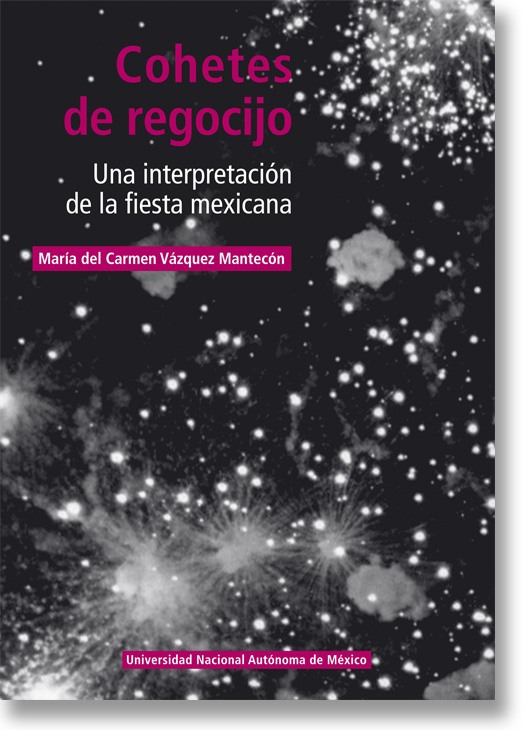
María del Carmen Vázquez Mantecón
Cohetes de regocijo
Una interpretación de la fiesta mexicana
Primera edición, México,
Universidad Nacional Autónoma de México, Instituto de Investigaciones Históricas, 2017, 264 páginas, imágenes (Historia General 35)
ISBN 978-607-02-9484-6
ISBN 978-607-02-9484-6
La fiesta novohispana y mexicana, que tuvo lugar entre las últimas décadas del siglo XVI y la primera del XX, se caracterizó por un uso abundante e imprescindible de fuegos de artificio. Con éstos se buscaba que cada celebración fuera la muestra más notable de regocijo, de alabanza, de lealtad y de legitimación. A través de sus luces y fuegos, es posible hacer una peculiar lectura de cada microcosmos festivo. Se revela su propósito, su mensaje, la visión del mundo en boga, el impacto que buscaron sin escatimar recursos, la bella arte efímera que significó su fabricación desde el contexto marginado en el que se tuvo siempre a los artificieros, y el efecto que atesoraron en los variados sentimientos y creencias de los espectadores. Para dar cuenta de todo esto, fue necesario conocer algunos de los pormenores de la pirotecnia militar y de gozo que floreció en el siglo XVI con el desarrollo de la artillería, que ha vinculado desde entonces, a partir del uso de la mezcla de salitre, carbón y azufre, a la guerra y la fiesta. Lugar especial en esta investigación, lo ocupan, asimismo, los avatares de la pólvora durante la conquista y su impacto decisivo en la mentalidad indígena, que se apropió solemnemente de ella, alcanzando los coheteros mexicanos muy pronto, gran habilidad y una merecida reputación a los ojos extranjeros.Se trata de un recorrido por las fiestas religiosas, civiles y mundanas de la ciudad de México en el período elegido, que reveló, mediante el uso de tronadores y deslumbrantes artificios, el imaginario importado, sobre todo de Francia y España, así como el propio, que nutrieron a cada época en sugerentes símbolos, emblemas y alegorías, encontrando, por ejemplo, una respuesta al porqué de la pervivencia bulliciosa en la historia cultural mexicana de figuras como la del castillo o la del torito. Sobre éste último y a propósito de la quema de los tradicionales Judas del Sábado de Gloria, se ofrece en este libro una interpretación diferente a lo que de ambos se ha dicho hasta ahora. Entre otros asuntos, encontrará también el lector una reflexión sobre el ambiguo significado del incendio de los cohetes y sobre la magia de la noche que, con sus fuegos iluminando la bóveda del cielo, llevaba a cada fiesta a su momento más esperado.
Between the last decades of the sixteenth century up until the first of the twentieth, festivities in New Spain and in Mexico, were characterized by the extensive and indispensable use of fireworks. The idea was to make each celebration the most notable in terms of merriment, praise, loyalty and legitimacy. By virtue of lights and fire it is possible to make a peculiar reading of each festivity’s microcosm. Fireworks reveal the purpose and the message of these celebrations, the vision of the world at the time and the impression people expected to give in sparing no expense on these festivities. They also unveil the beautiful ephemeral art that is the fabrication of fireworks from the point of view of their creators, who have always been seen as outcasts, as well as the effect pyrotechnics had on the different emotions and beliefs of the spectators. In order to give an account of all these things, it was necessary to delve into the small details of military pyrotechnics, as they happened to flourish in the sixteenth century with the development of artillery, something which —by way of saltpeter, charcoal, and sulphur— has since brought together war and celebration. Also, this work pays special attention to the avatars of gunpowder during the conquest of New Spain, and its definitive influence on the indigenous people minds of the indigenous peoples; who quickly embraced the craft, and very soon Mexican coheteros became known for their ability, acquiring international renown.This book is a journey through civil, mundane and religious celebrations in Mexico City, during the period above mentioned. A journey which, via firecrackers and dazzling artifice, unveils the very important imagery —particularly that from Spain and France, as well as our own— which nurtured each period with evocative symbols, emblems and allegories. For example, this work provides an answer as to why boisterous figures like the castillo or the torito prevail in Mexican cultural history. On the latter and about this last one and about the traditional burning of Judas effigies on Holy Saturday, this book offers a different interpretation from what has been said so far about them both. The reader will find, amongst other things, that this book reflects as well on the ambiguous significance of the burning of fireworks and on the magic of night that, with fire illuminating the skies, takes each celebration to its most anticipated moment.
INTRODUCCIÓNDE ALQUIMIAS, PÓLVORAS, ARTILLERÍAS Y PIROTECNIASLA FIESTA Y LA GUERRALA BÓVEDA CELESTEEL FUEGO Y EL ARTE DE LA PIROTECNIA DE REGOCIJOLA PÓLVORA DURANTE LA CONQUISTAQUEHACER DE LA PÓLVORA EN LA VIDA COTIDIANA DE LOS COHETEROSFUEGOS Y LUCES DE LAS SOLEMNIDADES NOVOHISPANAS Y MEXICANASCONTEXTO IMAGINARIO DE LA PIROTECNIA FESTIVA FRANCESA Y ESPAÑOLAIMAGINARIOS HEREDADOS Y PROPIOSLINAJE DE LOS TORITOS MEXICANOSEL INCENDIO DE LOS FUEGOS ARTIFICIALESNOCHE DE FIESTA, APOGEO Y MAGNIFICENCIAJUDAS Y LA TRAICIÓN EN MÉXICOEPÍLOGOFUENTES DOCUMENTALES Y BIBLIOGRÁFICASRELACIÓN DE IMÁGENES

